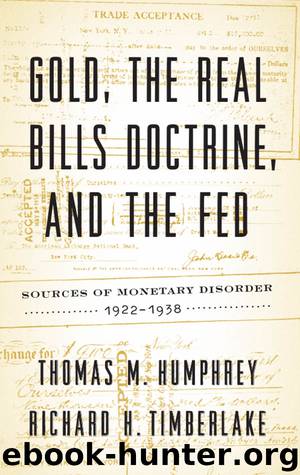Gold, the Real Bills Doctrine, and the Fed: Sources of Monetary Disorder, 1922-1938 by Richard H. Timberlake

Author:Richard H. Timberlake [Timberlake, Richard H.]
Language: eng
Format: epub
Publisher: Cato Institute
Published: 0101-01-01T00:00:00+00:00
THE CASE FOR THE TRADITIONAL GOLD STANDARD
The fourth paper of the Chicago conference, “The Future of the Gold Standard,” by Lionel D. Edie, an economist with the Investment Research Corporation and a former professor of finance at the University of Chicago, accurately described the gold standard and the impediments Fed policy had introduced to its functioning. Edie first discussed the Bank of England’s abandonment of gold parity in September 1931, the event that had prompted the conference. He noted that the United States still had over $4 billion of gold, an amount that “would be ample to support the functioning of the Federal Reserve System.” However, he added, “The hoarding of [hand-to-hand] currency has given rise to alarm . . . due to the provisions of Federal Reserve note issue. . . . When collateral is limited additional [Fed] note issue by banks must be backed practically 100 per cent by gold” (Edie [1932] 1983: 114).
Edie here referred to the original Federal Reserve Act, which required Federal Reserve notes to be backed 40 percent by gold, while the remaining 60 percent could be secured by “eligible paper,” that is, real bills. However, if no real bills were “available,” the issue of notes had to be collateralized 100 percent by gold. Nothing “speculative,” such as stock market assets, or anything long-term or “unproductive,” such as government securities or mortgages, were legal collateral.4
Edie gave an accurate précis of how gold under a gold standard regulated the money supply. “Due to its limited production,” Edie explained, “the gold stock cannot be subject to violent fluctuations. This relative stability in gold supply over short periods commends gold highly as a monetary base. In brief, the primary economic function of the gold standard is a supply [of money] function. This supply function is to protect economic society from excessive short-term fluctuations in money” (118). Unfortunately, Edie continued:
Something has gone wrong in the machinery for relating [bank] credit to gold . . . with the result that . . . the gold base does not hold the credit superstructure in line. The Federal Reserve Act cut the tie which binds the gold reserve directly to the credit volume and by so doing automatically cut off the basic function of the gold standard. . . . People talk about abandoning the gold standard, without realizing that in an essential respect we abandoned it some time ago. . . . We did so unintentionally and unconsciously, but effectively none the less. We are not now on the gold standard, in so far as its supply [of money] function is concerned, and we have not been for some time. True, we have the trappings, earmarks, and accessories of the gold standard, but we do not have the essential economic service of that standard because gold has been divorced from [bank] credit. Member bank reserve balances [accounted in Federal Reserve Banks’ balance sheets] are the intermediary between gold and [commercial bank] credit. These balances are the active base of our whole banking system.
Download
This site does not store any files on its server. We only index and link to content provided by other sites. Please contact the content providers to delete copyright contents if any and email us, we'll remove relevant links or contents immediately.
International Integration of the Brazilian Economy by Elias C. Grivoyannis(90729)
The Radium Girls by Kate Moore(11921)
Turbulence by E. J. Noyes(7935)
Nudge - Improving Decisions about Health, Wealth, and Happiness by Thaler Sunstein(7615)
The Black Swan by Nassim Nicholas Taleb(7010)
Rich Dad Poor Dad by Robert T. Kiyosaki(6399)
Pioneering Portfolio Management by David F. Swensen(6226)
Man-made Catastrophes and Risk Information Concealment by Dmitry Chernov & Didier Sornette(5921)
Zero to One by Peter Thiel(5684)
Secrecy World by Jake Bernstein(4643)
Millionaire: The Philanderer, Gambler, and Duelist Who Invented Modern Finance by Janet Gleeson(4374)
The Age of Surveillance Capitalism by Shoshana Zuboff(4209)
Skin in the Game by Nassim Nicholas Taleb(4161)
Bullshit Jobs by David Graeber(4094)
The Money Culture by Michael Lewis(4074)
Skin in the Game: Hidden Asymmetries in Daily Life by Nassim Nicholas Taleb(3929)
The Dhandho Investor by Mohnish Pabrai(3698)
The Wisdom of Finance by Mihir Desai(3650)
Blockchain Basics by Daniel Drescher(3495)
